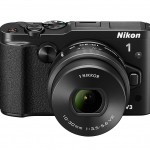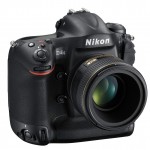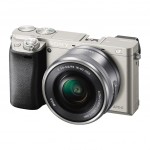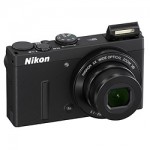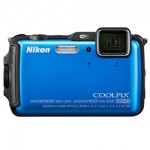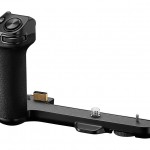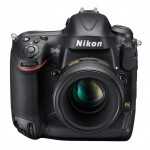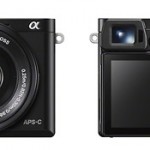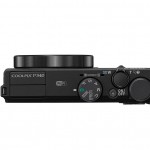Here's another professional review, by Mark Eastman, for your perusal.
As usual, feel free to post comments on the review, or share your own experience with the camera. Of course, if you have extensive esperience wth the Nikon D2H, we need you to go ahead and post a review >>
Here's the review...
************************************************** ******************************
The Nikon D2H is a professional-level 4.1 megapixel digital SLR designed for photojournalists and sports photographers.Price: Currently less than $2000 US
Pros
- Outstanding ergonomics, professional quality build, and light weight
- Outstanding battery performance
- Excellent image quality
- Nikon 3-D Color Matrix Metering
- Instant on/off
- Large image buffer: 8 fps (40 JPEG/25 RAW continuous shooting)
- 11-segment auto focus
Cons
- Lower resolution than competitive digital SLRs
- 1.5x digital crop factor
- Noise apparent in higher ISO images
- AC adapter not included (required to lock mirror-up to clean sensor)
Nikon D2H Studio Test Images
ISO 200 Sample
ISO 400 Sample >>
ISO 800 Sample >>
ISO 1600 Sample >>
More Nikon D2H Resources
All Nikon D2H Photos >>
Read reviews by Nikon D2H owners >>
Post your own Nikon D2H Review >>
Nikon Web site >>by Mark Eastman
Introduction
First introduced in late 2003, the D2H represents a significant step forward in Nikon's Digital SLR line, which began with the D1. With a modestly sized 4.1 megapixel sensor, fast 8 fps frame rate and large image buffer (40 continuous frames JPEG and 25 RAW), the D2H is well suited for photojournalism where speed, build, and professional features outweigh being able to produce prints larger than 8"x12".The D2H accommodates professional photographers with a well designed, lightweight, extremely responsive pro-level Digital SLR that produces excellent results under most conditions. The D2Hs recently replaced the D2H. The new camera uses the same basic body and 4.1 megapixel sensor and adds a larger buffer with minor metering, improved auto focus and a few other improvements. The D2H is still worth looking at. It might be a bargain for someone not willing to pay for the D2X or D2HS. And it shares enough with the new D2Hs, that the reading the review will still be useful for someone considering buying a D2Hs.
Design
Front and rear of the Nikon D2H shutter release and exposure control dials.Instead of using an existing body design, Nikon went back to the drawing board for the D2H.It feels very solid and fits the hand ergonomically with most all of the controls and buttons logically placed and easy to access. There are two sets of command dials for both vertical and horizontal shooting positions. The lightweight body has a magnesium alloy internal construction for easy handling compared to previous Nikon dSLRs and professional 35mm SLR bodies, while retaining the same ruggedness and attention to detail Nikon is renowned for. The removable battery compartment panel is solidly built and matches the contour of the body well. The viewfinder's eyepiece has a large exit pupil with a rubber ring, built-in diopter adjustment and a shutter curtain to prevent light from entering the eyepiece when making exposures on a tripod. The front of the viewfinder has a distinctive small white diffuser for measuring ambient light.
Nikon D2H Features
The D2H is a true professional camera with features to match. The first thing you notice is the almost instantaneous startup. The control placement and shooting modes are similar to previous pro-level Nikon SLRs with mode settings for Aperture Priority, Shutter Priority, Manual, and Program Auto. The D2H auto focus system has been entirely revamped and now has eleven main sensor areas. The camera can capture NEF RAW and JPEG files at the same time. With a maximum capture resolution of 2464x1632 pixels; the exclusive 4.1 megapixel Nikon JFET LBCAST sensor has a digital 1.5x crop factor. The camera's ISO range is 200-1600.
Top view of the D2H, with shutter mode selection dial on the left and the main control panel display, shutter release, and on/off switch on the right.The traditional camera controls are all on the top of the camera. The on/off switch, shutter release, main control panel display with shooting mode, aperture, shutter speed, battery level indicator, frame count, auto focus controls, and flash settings, are all located on the top right of the camera body. Both the top LCD display and the main control panel on the top of the camera have a backlight illuminator that stays on for a few seconds then automatically shuts off. An additional shutter release with a locking tab is located on the bottom right front of the camera, for vertical shooting. The top left of the camera has a shutter mode selection dial and buttons for bracketing, flash options, and aperture lock.
The eleven-sensor D2H auto focus with Nikon's new Multi-cam 2000 auto focus module is very effective. There are three main auto focus settings that can be selected with a lever on the front of the body: manual, Single Servo AF, and Continuous Servo AF. There are also four, more specific auto focus options: Single Area AF and Dynamic area AF - (where you manually select an auto focus segment in the viewfinder), Group Dynamic AF (automatic within a selected group), and Dynamic Area AF with closest subject priority (automatic focusing on the closest subject).
One of the most noticeable features on the D2H is the 2.5-inch LCD preview screen. It has an excellent, bright, clear display and the current firmware supports 30x magnification, which makes it easy to quickly check focus on even the smallest image details. There is also a preset magnification you can toggle on and off by pressing the "Enter" button while viewing an image. A clear plastic monitor protector is included with the camera. It protects the monitor well, but can easily pop off the camera. Some photographers use clear tape to keep it on. I bought an extra one I keep in my bag.
Basic preview on the 2.5-inch D2H LCD.
Image preview with histogram.
Menu detail, with the Shooting Menu selected.The camera menu is controlled with the Multi Selector knob, located to the left of the main LCD. There are four different menus indicated by colored tabs on the left side of the LCD screen. The menus offer control of ISO, image quality settings, custom settings, playback options, white balance, card formatting, etc. White balance, ISO, resolution, and JPEG quality can all be controlled with buttons outside of the menu, as well. The D2H offers full white balance controls, including Auto, presets, and custom. The ISO range is 200-1600, expandable to IS0 6400.
If you own or use manual focus Nikkor AIS lenses, you'll be pleased to know the D2H can use Nikon Matrix metering with most non-CPU Nikon AIS manual focus lenses. Lens information can be set in the Shooting Menu so the aperture will be correctly displayed on the LCD and focal length and aperture info will also be included in the EXIF data. Shutter priority and Program mode will not work with non-CPU AIS lenses on the D2H.
The D2H also features built-in 802.11b Wi-Fi compatibility when used with Nikon's optional WT-1 accessory. The WT-1 plugs into the camera's USB 2.0 port and allows wireless transmission of image files to a computer through a wireless access point. The wireless system has a range of about 100 feet (30 meters).
Performance
The D2H is a very fast camera. As mentioned earlier, startup is nearly instantaneous. The auto focus is extremely quick and accurate when paired with Nikon AF-S lenses. Depressing the shutter release button halfway brings your subject almost instantly into focus. The auto focus is noticeably slower, but still precise, with standard Nikon AF lenses. This is most apparent when shooting in Continuous Servo AF mode with non AF-S telephotos. The D2H's Continuous Servo auto focus allows you to photograph a moving subject and keep it in focus while you are shooting - the camera automatically tracks the subject so that it remains in focus for every frame in the sequence. I've found this invaluable for photographing sports events like track runners, where you may not be able to refocus fast enough as a subject approaches. The camera buffer is also excellent. It can capture 40 JPEG and 25 NEF RAW frames without pausing. For reference, this means you can shoot an entire corner kick sequence in a soccer match. The new Nikon D2Hs has a larger buffer and can shoot 50 JPEG frames and 40 RAW frames continuously, however the D2H's 40/25 buffer is sufficient for most situations.The combination of 3-D Matrix Color Metering and white balance on the D2H is one of its most impressive features. I've used the camera with slow sync flash in a variety of mixed lighting situations and the metering is outstanding. The TTL flash metering with the SB-800 flash is also excellent. Wireless slave sync capability means you can sync multiple SB-800s for creative lighting, on location.
Nikon introduced a new battery system for the D2H. The EN-EL4 lithium-ion battery is excellent. Combined with the reduced power consumption of the camera's JFET LBCAST imaging sensor you can count on quite a bit of shooting per charge. It charges up reasonably quickly with the supplied charger. Actual number of frames per charge depends on how much the LCD is used as well as Auto Focus and VR if used, but it's very good. I've gotten by with a single extra battery in the D2H for most jobs, including sports and event photography.
Image Quality
The D2H's image quality is very impressive despite having a modest sensor size compared to other current digital SLRs. It produces sharp and clear images with excellent sharpness, tone, and color. Like most digital cameras it will not produce optimal results in high contrast lighting or in low available light situations. 8"x12" is the recommended maximum print size. However it is possible to upsample to produce high-quality prints at larger sizes. As mentioned before, the menu offers controls for tuning saturation, sharpness and other aspects of image quality. To make your own judgment about D2H image quality, check the full-resolution studio samples in the gallery.
The noise level can be significant when shooting at higher ISO settings. I've found some of this can reduced with third party noise reduction software like Noise Ninja.
Camera Experience
I've used the D2H for nearly a year and a half, in a variety of shooting conditions and situations, and it has generally produced excellent results. Personally, I've found I get the best results from the camera by shooting in RAW mode. The camera's internal processor doesn't touch the Nikon NEF RAW files. Therefore, they offer the ultimate potential and flexibility. They allow the photographer ultimate control of image quality. This is true for all digital cameras that offer RAW capture. Most professional photographers use RAW files when image quality is a top priority.The ability to shoot in RAW mode is especially useful for shooting in adverse conditions or where sharpness and color accuracy are critical. In the fall, I documented the opening round of the O'Neill Cold Water Classic surf competition. The competition took place on a cold, dark, rainy day. Shooting in RAW and using post-processing software tools allowed me to produce images I could not have produced on film in the same conditions. Although the images had a level of noise inherent to higher ISO settings, I was able to correct them to an acceptable level that wouldn't have been possible shooting in JPEG. I actually shot some color negative film at the event and it confirmed how adverse the photographic conditions were.
I've used my D2H primarily for shooting action sports, indoor event's and some portrait work. It's extremely fast; the image buffer is enough to photograph an entire corner kick sequence in a soccer match. Being freed up from the cost of film, along with the fast frame rate allows the photographer to shoot fast moving action in bursts and edit later. This makes a big difference when it comes to making sure you get the shot.
Conclusion
The Nikon D2H is an excellent DSLR with reasonable resolution and a broad range of professional features that will more than accommodate most photographers' needs. Like most cameras, the D2H is better for some kinds of photography than others. It excels where speed is a top priority. The Nikon D2H is an excellent value for a professional level dSLR . It even measures up against its replacement, the D2Hs, with which it shares most of the same features at significantly lower price.Who Should Buy The Nikon D2H
The D2H is a great camera for photographers who shoot sports, events, documentary, or portrait work. If you can accept a 4.1 megapixel sensor and need a fast, accurate digital SLR with professional features and TTL flash capability, then the D2H is a photographic bargain. The camera is best suited for images intended to be reproduced as prints at 8"x12" or smaller. Whether you're an intermediate amateur or an experienced professional, the camera is easy to use and has everything you could want in terms of exposure control, auto focus, speed, and accurate metering.-end-
What's In The Box
Contents of the Nikon D2H box.
- D2h Body
- Body Cap
- Li-ion Battery EN-EL4
- Battery Charger MH-21
- Camera Strap AN-D2H
- LCD Monitor Cover BM-3
- AV Cable UC-E4
- USB Cable EG-D2
- Nikon Flash Memory Card
- Manual
- Nikon View Software CD-ROM
Other Resources:
Nikon D2H User Reviews >>
Write a Nikon D2H Review >>
Nikon D2H Sample Gallery >>
Studio Sample Images >>
Nikon Web site >>




 LinkBack URL
LinkBack URL About LinkBacks
About LinkBacks







 Reply With Quote
Reply With Quote
